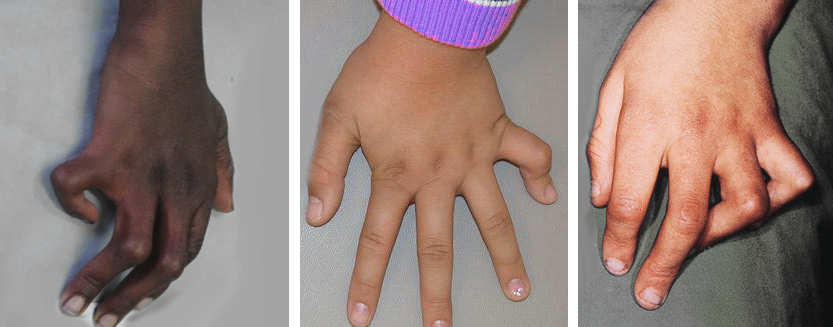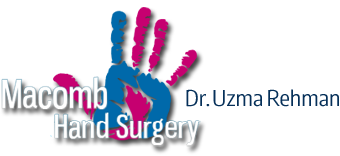Camptodactyly (Bent Fingers) In Children
“Camptodactyly” is the medical term for a condition in which a child was born with a bent finger (or fingers) that cannot completely straighten. Though it can be very concerning to new parents who have never heard of this issue, it is quite common – affecting about 1% percent of all children to some degree.
The good news is that Camptodactyly is very treatable, usually without requiring surgery. So, in most cases, children with this “bent finger” condition will have full use of their hands and fingers, as long as they receive prompt and proper hand therapy.
In this article, renowned Detroit area hand surgeon Dr. Uzma Rehman discusses Camptodactyly (bent fingers) in children.
What Causes Camptodactyly (Bent Fingers)
Camptodactyly actually does not have a single cause, but rather can be caused by a number of different structural abnormalities in a child’s finger(s). Some of the most common causes of Camptodactyly (bent fingers) in children include:
- tight skin
- contraction of the tendons and ligaments
- abnormal muscle formation
- irregularly shaped bones
In other extremely rare cases Camptodactyly can also be the result of an underlying syndrome that also has associated facial, dental, or other anomalies.

Treating Camptodactyly (Bent Fingers) in Children
Because there is no single cause of Camptodactyly, no one single treatment is recommended for all children. An experienced hand surgeon, like Dr. Uzma Rehman in the Detroit area, can examine your child and X-ray the fingers to diagnose the underlying cause of the bent finger(s), and then recommend the best treatment.
Mild finger curvature (less than 30 degrees) rarely causes pain and usually does not result in any functional problems. So, in most cases, surgery is not needed, and some form of splinting and occupational hand therapy will be sufficient to correct the issue.
In rare cases an experience hand surgeon may recommend surgery. Cases where surgery may be the best treatment option for Camptodactyly include:
- If the angle of the bend is greater than 30 degrees
- When the child’s finger curvature increases rapidly
- If the curvature of the finger(s) interferes with hand functioning
While the specific type of surgery needed for Camptodactyly will vary, depending upon the underlying cause, there is no need to worry. These surgeries are very routine and very safe for the child, when performed by and experienced hand surgeon like Dr. Rehman.
What to Do if Your Child has Bent Fingers (Camptodactyly)
If you notice that your child has one or more fingers that appear permanently bent at the middle joint (PIP joint), they may have a condition called camptodactyly. This congenital hand difference typically affects the small finger, though it can occasionally involve multiple digits. As a parent, recognizing this condition early is important, but there’s no need for immediate panic. Camptodactyly is often painless and may not significantly impact function, particularly when identified and addressed promptly. The first step should be scheduling an evaluation with a hand specialist experienced in pediatric hand conditions to obtain an accurate diagnosis and treatment recommendations.
During your child’s evaluation, Dr. Uzma Rehman, a leading Detroit area hand surgeon, will conduct a thorough assessment including a detailed family history, as camptodactyly sometimes has a genetic component. “We carefully examine not only the affected finger but the entire hand to understand the specific anatomical factors contributing to your child’s camptodactyly,” explains Dr. Rehman. “This comprehensive evaluation helps determine whether the bent finger results from tendon anomalies, muscle imbalances, or other structural differences.” X-rays or other imaging studies may be recommended to rule out bone abnormalities and provide additional diagnostic information, though camptodactyly primarily involves soft tissue differences rather than skeletal issues.
Treatment approaches for camptodactyly vary based on factors including the child’s age, the severity of the bend, progression pattern, and any functional limitations. For mild cases identified early, Dr. Rehman often begins with non-surgical interventions such as specialized stretching exercises and custom splinting programs designed to gradually improve finger extension. These conservative approaches prove particularly effective when initiated before growth spurts that might otherwise exacerbate the condition. Parents play a crucial role in this treatment, as consistent home exercise completion significantly influences outcomes. Dr. Rehman and her hand therapy team provide detailed guidance and support to ensure proper technique and adherence to the recommended protocol.
For more severe cases or those that progress despite conservative management, surgical intervention may be considered, particularly if the bent finger significantly affects function or causes psychosocial concerns as the child grows. “Surgical approaches for camptodactyly are highly individualized based on the specific anatomical issues identified,” notes Dr. Rehman. “These procedures might involve tendon releases, transfers, or other techniques designed to rebalance the forces acting on the affected digit.” Following surgery, specialized hand therapy protocols help maximize results and restore optimal function. Throughout both surgical and non-surgical treatment pathways, Dr. Rehman emphasizes the importance of regular follow-up throughout childhood and adolescence, as camptodactyly can sometimes progress during growth spurts, requiring treatment adjustments to maintain improvements.
Prognosis for Children with Camptodactyly
The vast majority of children with Camptodactyly have no interference with the function of their hand(s). And, in most cases, physical therapy and splinting can reduce the bend so that it is not cosmetically noticeable.
In extreme cases, where surgery is recommended, the surgery is usually successful in substantially correcting the curvature – leaving the child only with some minor residual bending. And function of the hand is typically able to be fully restored. In some very rare cases, there is a risk for recurrence and the need for future additional surgery.
Camptodactyly Hand Surgeon – Detroit
Detroit area hand surgeon Dr. Uzma Rehman has treated hundreds of babies and children with Camptodactyly and other hand problems. She understands that, as a parent, anytime your child has a medical issue it is worrisome and even frightening.
Please know that with expert diagnosis, treatment, and care, Camptodactyly is highly treatable – so that your child can live a full and happy life. Dr. Rehman will always explore the least invasive and safest treatments for straightening your child’s finger(s), in a caring and compassionate environment.
For comprehensive care and state-of-the-art treatment for any congenital or acquired medical conditions of the fingers, hand, wrist or arm, call Dr. Rehman today.

